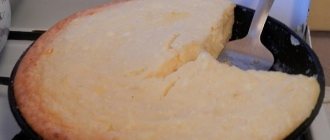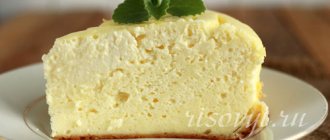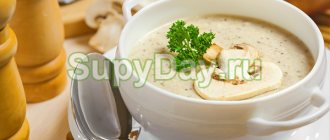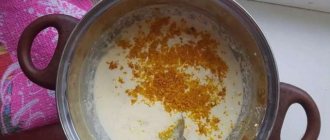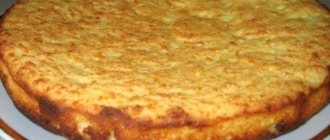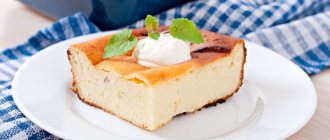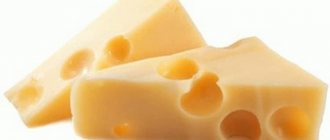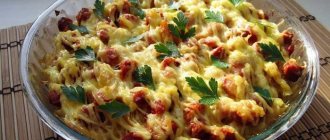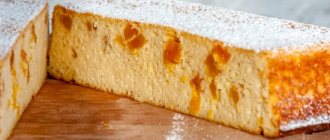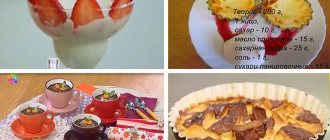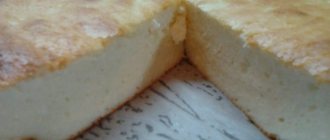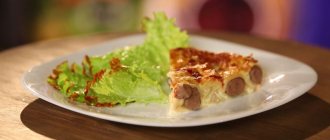Benefits of cottage cheese
Cottage cheese is a very healthy product that is necessary for both adults and children. To understand the benefits of cottage cheese and how it affects digestion, it is worth turning to the chemical composition of this product.
First of all, it is a storehouse of protein, moreover, protein that is absorbed by the body several times better than animal protein.
The presence of amino acids in its composition makes it simply an indispensable product for people with liver and heart problems.
Cottage cheese and products made from it are indicated for people with edematous kidney diseases. Since cottage cheese contains calcium, which helps remove excess fluid from the body.
In addition to protein and amino acids, it is a source of vitamins A and B, as well as the elements calcium, potassium, magnesium, and phosphorus.
I would especially like to note the benefits of cottage cheese and cottage cheese products for the female body - the beauty and shine of hair, the health of nails and teeth, and all kinds of diets based on cottage cheese. This is a must-have product in the diet of pregnant women and nursing mothers.
Recipe School cottage cheese casserole. Calorie, chemical composition and nutritional value.
Nutritional value and chemical composition of “School curd casserole”.
The table shows the nutritional content (calories, proteins, fats, carbohydrates, vitamins and minerals) per 100 grams of edible portion.
| Nutrient | Quantity | Norm** | % of the norm in 100 g | % of the norm in 100 kcal | 100% normal |
| Calorie content | 262.1 kcal | 1684 kcal | 15.6% | 6% | 643 g |
| Squirrels | 13.7 g | 76 g | 18% | 6.9% | 555 g |
| Fats | 6.2 g | 56 g | 11.1% | 4.2% | 903 g |
| Carbohydrates | 37.4 g | 219 g | 17.1% | 6.5% | 586 g |
| Organic acids | 0.6 g | ~ | |||
| Alimentary fiber | 1 g | 20 g | 5% | 1.9% | 2000 g |
| Water | 38.4 g | 2273 g | 1.7% | 0.6% | 5919 g |
| Ash | 2.073 g | ~ | |||
| Vitamins | |||||
| Vitamin A, RE | 57.6 mcg | 900 mcg | 6.4% | 2.4% | 1563 g |
| Retinol | 0.05 mg | ~ | |||
| beta carotene | 0.021 mg | 5 mg | 0.4% | 0.2% | 23810 g |
| Vitamin B1, thiamine | 0.059 mg | 1.5 mg | 3.9% | 1.5% | 2542 g |
| Vitamin B2, riboflavin | 0.194 mg | 1.8 mg | 10.8% | 4.1% | 928 g |
| Vitamin B4, choline | 52.04 mg | 500 mg | 10.4% | 4% | 961 g |
| Vitamin B5, pantothenic | 0.291 mg | 5 mg | 5.8% | 2.2% | 1718 g |
| Vitamin B6, pyridoxine | 0.123 mg | 2 mg | 6.2% | 2.4% | 1626 g |
| Vitamin B9, folates | 26.506 mcg | 400 mcg | 6.6% | 2.5% | 1509 g |
| Vitamin B12, cobalamin | 0.609 mcg | 3 mcg | 20.3% | 7.7% | 493 g |
| Vitamin C, ascorbic acid | 0.14 mg | 90 mg | 0.2% | 0.1% | 64286 g |
| Vitamin D, calciferol | 0.39 mcg | 10 mcg | 3.9% | 1.5% | 2564 g |
| Vitamin E, alpha tocopherol, TE | 0.589 mg | 15 mg | 3.9% | 1.5% | 2547 g |
| Vitamin H, biotin | 4.932 mcg | 50 mcg | 9.9% | 3.8% | 1014 g |
| Vitamin RR, NE | 3.3685 mg | 20 mg | 16.8% | 6.4% | 594 g |
| Niacin | 0.531 mg | ~ | |||
| Macronutrients | |||||
| Potassium, K | 110.43 mg | 2500 mg | 4.4% | 1.7% | 2264 g |
| Calcium, Ca | 98.63 mg | 1000 mg | 9.9% | 3.8% | 1014 g |
| Silicon, Si | 1.663 mg | 30 mg | 5.5% | 2.1% | 1804 |
| Magnesium, Mg | 17.73 mg | 400 mg | 4.4% | 1.7% | 2256 g |
| Sodium, Na | 683.65 mg | 1300 mg | 52.6% | 20.1% | 190 g |
| Sera, S | 140.5 mg | 1000 mg | 14.1% | 5.4% | 712 g |
| Phosphorus, P | 158.6 mg | 800 mg | 19.8% | 7.6% | 504 g |
| Chlorine, Cl | 635.74 mg | 2300 mg | 27.6% | 10.5% | 362 g |
| Microelements | |||||
| Aluminium, Al | 158 mcg | ~ | |||
| Bor, B | 17.5 mcg | ~ | |||
| Vanadium, V | 28.55 mcg | ~ | |||
| Iron, Fe | 0.83 mg | 18 mg | 4.6% | 1.8% | 2169 g |
| Yod, I | 2.08 mcg | 150 mcg | 1.4% | 0.5% | 7212 g |
| Cobalt, Co | 8.659 mcg | 10 mcg | 86.6% | 33% | 115 g |
| Manganese, Mn | 0.1316 mg | 2 mg | 6.6% | 2.5% | 1520 g |
| Copper, Cu | 71.47 mcg | 1000 mcg | 7.1% | 2.7% | 1399 g |
| Molybdenum, Mo | 9.001 mcg | 70 mcg | 12.9% | 4.9% | 778 g |
| Nickel, Ni | 3.187 mcg | ~ | |||
| Tin, Sn | 0.89 mcg | ~ | |||
| Selenium, Se | 19.935 mcg | 55 mcg | 36.2% | 13.8% | 276 g |
| Titanium, Ti | 2.47 mcg | ~ | |||
| Fluorine, F | 29.01 mcg | 4000 mcg | 0.7% | 0.3% | 13788 g |
| Chromium, Cr | 0.69 mcg | 50 mcg | 1.4% | 0.5% | 7246 g |
| Zinc, Zn | 0.5029 mg | 12 mg | 4.2% | 1.6% | 2386 g |
| Digestible carbohydrates | |||||
| Starch and dextrins | 18.797 g | ~ | |||
| Mono- and disaccharides (sugars) | 18.7 g | max 100 g | |||
| Essential amino acids | |||||
| Arginine* | 0.213 g | ~ | |||
| Valin | 0.216 g | ~ | |||
| Histidine* | 0.094 g | ~ | |||
| Isoleucine | 0.187 g | ~ | |||
| Leucine | 0.337 g | ~ | |||
| Lysine | 0.166 g | ~ | |||
| Methionine | 0.088 g | ~ | |||
| Methionine + Cysteine | 0.18 g | ~ | |||
| Threonine | 0.152 g | ~ | |||
| Tryptophan | 0.051 g | ~ | |||
| Phenylalanine | 0.217 g | ~ | |||
| Phenylalanine+Tyrosine | 0.342 g | ~ | |||
| Nonessential amino acids | |||||
| Alanin | 0.168 g | ~ | |||
| Aspartic acid | 0.234 g | ~ | |||
| Glycine | 0.146 g | ~ | |||
| Glutamic acid | 1.071 g | ~ | |||
| Proline | 0.33 g | ~ | |||
| Serin | 0.244 g | ~ | |||
| Tyrosine | 0.125 g | ~ | |||
| Cysteine | 0.091 g | ~ | |||
| Sterols (sterols) | |||||
| Cholesterol | 74.37 mg | max 300 mg | |||
| Saturated fatty acids | |||||
| Saturated fatty acids | 3.3 g | max 18.7 g | |||
| 14:0 Miristinovaya | 0.004 g | ~ | |||
| 15:0 Pentadecane | 0.001 g | ~ | |||
| 16:0 Palmitinaya | 0.214 g | ~ | |||
| 17:0 Margarine | 0.003 g | ~ | |||
| 18:0 Stearic | 0.092 g | ~ | |||
| 20:0 Arakhinovaya | 0.003 g | ~ | |||
| Monounsaturated fatty acids | 0.518 g | min 16.8 g | 3.1% | 1.2% | |
| 16:1 Palmitoleic | 0.041 g | ~ | |||
| 17:1 Heptadecene | 0.001 g | ~ | |||
| 18:1 Oleic (omega-9) | 0.426 g | ~ | |||
| 20:1 Gadoleic (omega-9) | 0.004 g | ~ | |||
| Polyunsaturated fatty acids | 0.131 g | from 11.2 to 20.6 g | 1.2% | 0.5% | |
| 18:2 Linolevaya | 0.115 g | ~ | |||
| 18:3 Linolenic | 0.006 g | ~ | |||
| 20:4 Arachidonic | 0.01 g | ~ | |||
| Omega-6 fatty acids | 0.1 g | from 4.7 to 16.8 g | 2.1% | 0.8% |
The energy value of school curd casserole is 262.1 kcal.
Primary Source: Created in the application by the user. Read more.
** This table shows the average levels of vitamins and minerals for an adult. If you want to know the norms taking into account your gender, age and other factors, then use the “My Healthy Diet” application.
The simplest - classic cottage cheese casserole
Unfortunately, it is not always possible to force a child to eat cottage cheese, and there is no need to tell him about its unparalleled benefits. It’s best to just take it and prepare some tasty and beautiful dish from it, for example, cottage cheese casserole.
There are a lot of recipes for cottage cheese casserole. However, there are certain ingredients that must be included in this dish. And what is especially important is compliance with the proportionality of the components and cooking technology.
Probably every housewife has her own secret for making casserole, her own secret additive that makes it unique.
The classic casserole recipe is reminiscent of homemade cheesecakes, only the cooking process is simpler and more straightforward. The main ingredients look like this:
- cottage cheese – 500 g;
- semolina – 100 g;
- sugar – 100 g;
- milk – 50 g;
- butter – 50 g;
- chicken egg – 2 pcs.
If desired, you can add vanillin, cinnamon or vanilla sugar. In some cases, you can replace sugar with powdered sugar, but more on that later.
Curd casserole like in kindergarten
So, for the casserole you will need:
- 500 gr. cottage cheese (we take wet cottage cheese, the percentage of fat content does not matter)
- 100 gr. Sahara
- 100 gr. decoys
- 50 gr. milk
- 50 gr. butter (butter should be soft)
- 2 eggs
- vanillin packet
Preparation:
1. Place cottage cheese, sugar, eggs, softened butter, milk and vanillin in a cup. Beat well with a mixer or blender.
2. Little by little, in a thin stream, add semolina, so that there are no lumps.
3. Place the finished mixture into the mold. You can line the pan with baking paper - then you don’t have to grease it with oil.
4. Leave the finished mass for 40 minutes for the semolina to swell.
5. Place the mold in the oven, bake at a temperature of 180-200 degrees, about 30 minutes, until golden brown (time calculation is given for a mold 26 cm in diameter). Readiness to determine with a wooden toothpick.
Please note: the baking time will depend on the size of the pan - if you are making a tall casserole in a small pan, the time can be safely increased to 40 minutes.
The process of making the most delicious cottage cheese casserole
Sometimes it is not always enough to take the right products; it is also important to know how to prepare a tasty and healthy dish from them.
Preparing the dough for casserole
To do this, take the cottage cheese and grind it through a sieve. This procedure is needed to crush large pieces and give airiness to the future product.
A small digression - it is better to take cottage cheese by weight, since it has a high fat content. The optimal option is 5-9%, but it will not spoil the casserole and cottage cheese with 18% fat content.
If you have chosen curd mass or soft cottage cheese for the casserole, then the step of rubbing through a sieve can be omitted.
Next, add eggs and sugar and mix. Here you can also consider several options:
- First, you can stir the mass with a fork, then the casserole will turn out loose with individual pieces of cottage cheese.
- The second option is to beat the mass using a mixer. Then it’s better to use powdered sugar instead of sugar, and the casserole will turn out light and airy.
Adding semolina to cottage cheese casserole and cooking in the oven
It has already been mentioned that the most important thing in a casserole is to observe the correct dosage of ingredients.
The semolina should give the casserole even more airiness. But if you overdo it with semolina, the dough will turn out very dense. And after baking it will look like curd babka.
When you have added milk and semolina, leave the dough for half an hour or an hour.
While the dough is resting, you need to prepare a baking dish and prepare the oven. It is better to take a detachable form. Wrap it in foil to prevent the mixture from leaking out and burning during cooking.
Grease the pan with butter and sprinkle with breadcrumbs. Today, everything is done and produced to make it easier to improve any process - this means that the easiest way is to take a silicone mold, which will protect it from burning and is not worth the effort to wash.
Place the pan with the dough in the oven, which must be heated to 200° and left for 30-40 minutes.
Don't constantly look in and check for readiness. It is better not to open the oven lid at all during baking, otherwise the dough will “fall off” and the casserole will turn out “skinny”.
The appearance of a golden brown crust indicates that the casserole can be removed from the oven. Do not rush to remove the form immediately, let it cool.
How and with what to serve cottage cheese casserole?
In the meantime, you can prepare some sauce. There is only one limitation here - your imagination.
Serve the casserole with sour cream or sour cream and strawberry sauce, condensed milk, jam, jam. Garnish the dish with a sprig of mint.
We looked at the classic version of making cottage cheese casserole. You can add berries and fruits, raisins, dried apricots, carrots to the dough - in a word, as many people, so many tastes.
How many different delicacies can be made from cottage cheese - cheesecakes, donuts, babka, dumplings. And, of course, the most delicious thing is the cottage cheese casserole, just like in childhood.
Curd casserole according to GOST
Preparing cottage cheese casserole according to GOST is very simple and quick. GOST is a quality standard that meets the needs of the child’s body. There is very little sugar in the casserole. Within 10 minutes you mix all the ingredients, the oven does the rest for you. Take cottage cheese that is not very fatty.
To prepare, take:
- Cottage cheese - 400 grams;
- Chicken egg - 1 piece;
- Milk - 150 Milliliters;
- Salt - 1 pinch;
- Sugar - 2 tbsp. spoons;
- Semolina - 40 grams.
How to cook “Cottage cheese casserole according to GOST”
Prepare ingredients for making cottage cheese casserole. Place the cottage cheese in a bowl. Add the egg. Pour milk. Beat cottage cheese, egg and milk with a blender. Add salt and sugar. And also semolina. Mix all the ingredients for the casserole. Place the curd mixture into a baking dish. Cook the cottage cheese casserole in the oven at 180 degrees for 35-40 minutes until golden brown. Cool the finished casserole slightly, cut into portions and serve with sour cream, honey, and condensed milk.
